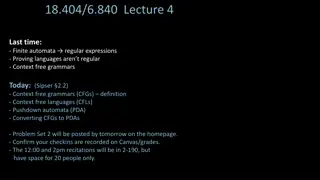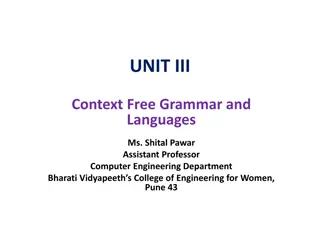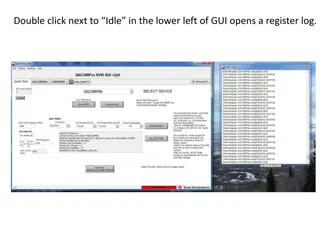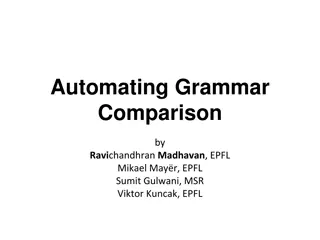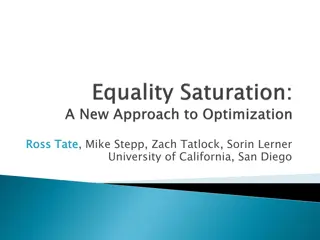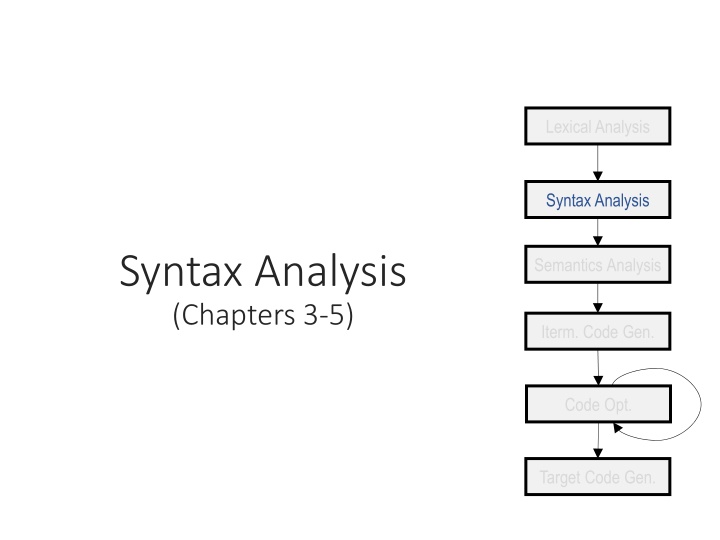
Context-Free Grammars and Parsing Techniques
Explore the concepts of context-free grammars, Backus-Naur Form (BNF), and parsing in programming language theory. Learn how syntax analysis, lexical analysis, and semantic analysis contribute to understanding the structure of programs. Discover the significance of derivations and leftmost/rightmost derivations in generating valid token strings for parsing.
Download Presentation

Please find below an Image/Link to download the presentation.
The content on the website is provided AS IS for your information and personal use only. It may not be sold, licensed, or shared on other websites without obtaining consent from the author. If you encounter any issues during the download, it is possible that the publisher has removed the file from their server.
You are allowed to download the files provided on this website for personal or commercial use, subject to the condition that they are used lawfully. All files are the property of their respective owners.
The content on the website is provided AS IS for your information and personal use only. It may not be sold, licensed, or shared on other websites without obtaining consent from the author.
E N D
Presentation Transcript
LexicalAnalysis SyntaxAnalysis Syntax Analysis (Chapters 3-5) Semantics Analysis Iterm. Code Gen. Code Opt. Target Code Gen.
Parsing Determine the syntax (structure) of a program based on the token sequence; Typically, parser drives scanner token sequence parse/syntax tree Parser getToken() parse/ syntax tree Parser Scanner a token One-Pass
Context-Free Grammars Backus-Naur Form (BNF) - first used for ALGOL 60 - developed by John Backus and Peter Naur <exp> ::= <exp> <op> <exp> | ( <exp> ) | number <op> ::= + | - | *
Context-Free Grammars A Rule in BNF - left-hand side (LHS) defines the name of a structure (nonterminal) - right-hand side (RHS) gives its possible layouts (sequence of terminals & nonterminals) exp exp op exp |( exp )|number structure name possible layouts
Context-Free Grammars Derivation - a sequence of replacements of structure names by layouts on RHS, starting from the start nonterminal Start Nonterminal exp exp op exp exp op number number op number number * number (1) exp exp op exp (2) exp ( exp ) (3) exp number (4) op + (5) op - (6) op * a legal token string with terminals only CFG
Context-Free Grammars Derivation - Leftmost derivation: the leftmost nonterminal is replaced in each step (1) exp exp op exp (2) exp ( exp ) (3) exp number (4) op + (5) op - (6) op * exp exp op exp ( exp ) op exp ( exp op exp ) op exp ( number op exp ) op exp ( number - exp ) op exp ( number number ) op exp ( number number )* exp ( number number )*number CFG
Context-Free Grammars Derivation - Rightmost derivation: the rightmost nonterminal is replaced in each step (1) exp exp op exp (2) exp ( exp ) (3) exp number (4) op + (5) op - (6) op * exp exp op exp exp op number exp *number ( exp )*number ( exp op exp )*number ( exp op number )*number ( exp number )*number (number number )*number CFG
Context-Free Grammars Exercise Use leftmost/rightmost derivation to construct the token string (1) exp exp op exp (2) exp ( exp ) (3) exp number (4) op + (5) op - (6) op * exp ( number * (number number))
Context-Free Grammars Language - the set of token strings obtained from all possible derivations is the language defined by the CFG L(G) = { s | exp * s} exp exp op exp |( exp )| number op +|-|* derive ( number - number ) * number a legal token string
Context-Free Grammars Comparison to Regex - both use alternation, concatenation, and name - no repetition * , but recursion ( instead of = ) - more powerful (balanced parentheses S ( S ) S | ) - terminals are tokens recursion exp exp op exp |( exp )|number op +|-|* CFG tokens number = digitdigit* digit = 0|1|2|3|4|5|6|7|8|9 regex
Context-Free Grammars Exercise - What is the language of the following grammar? E ( E ) E E+ a E a {a, a+a, (a), (a)+a, (a+a), ...}
Context-Free Grammars Example - Nested if-statments in a C-like form statement if-stmt | other if-stmt if(exp )statement |if ( exp ) statement else statement exp 0 | 1 other if (0) other if (1) other if (0) other else other if (0) if (0) other ...
Context-Free Grammars Example - A sequence of statements ; s; s;s; s;s;s; ... stmt_sequence stmt ; stmt-sequence | stmt ; stmt s |
Parse Tree A labeled tree corresponding to a derivation - Internal nodes: nonterminals - Leaf nodes: terminals - Children parent relation: a derivation step (1) exp exp exp op exp number op exp number + exp number + number (1) (2) (3) (4) (3) exp (2) op exp (4) number + number Leftmost Derivation
Parse Tree A labeled tree corresponding to a derivation - Internal nodes: nonterminals - Leaf nodes: terminals - Children parent relation: a derivation step (1) exp exp exp op exp exp op number exp + number number + number (1) (2) (3) (4) (3) exp (4) op exp (2) number + number Rightmost Derivation
Parse Tree Exercise: what is the parse tree of this derivation? exp exp op exp exp op number exp *number ( exp )*number ( exp op exp )*number ( exp op number)*number ( exp -number)*number (number-number)*number (1) (2) (3) (4) (5) (6) (7) (8)
Parse Tree Issue: match derivation well, but not in a concise form exp exp * op exp number ( exp ) * 42 - exp op exp 34 3 - number number
Abstract Syntax Tree (AST) a.k.a. Syntax Tree - abstract syntactic structure (may miss some syntax details) - token sequence may NOT be recoverable from the AST - still contains all necessary info for translation * (34 3) * 42 42 - ((34 3)) * 42 ((34 3) * 42) 34 3
Abstract Syntax Tree (AST) 2nd Example if (0) other else other statement if-stmt | other if-stmt if(exp )statement |if ( exp ) statement else statement exp 0 | 1 statement if-stmt Parse Tree ) else statement statement ( exp if other other 0
Abstract Syntax Tree (AST) 2nd Example if (0) other else other statement if-stmt | other if-stmt if(exp )statement |if ( exp ) statement else statement exp 0 | 1 if else-part (if present) AST condition then-part other 0 other
Abstract Syntax Tree (AST) 3rd Example s;s;s; stmt_sequence stmt; stmt-sequence | stmt; stmt s | stmt-sequence stmt-sequence ; stmt Parse Tree ; stmt-sequence s stmt s stmt ; s
Abstract Syntax Tree (AST) 3rd Example s;s;s; stmt_sequence stmt; stmt-sequence | stmt; stmt s | ; seq seq s ; child AST s s s s s s s ; sibling sibling (leftmost-child right-sibling) s
Ambiguous Grammar A grammar allowing a string to have more than one parse tree exp exp op exp |( exp )| number op +|-|* | / 34 3 * 42 exp exp exp op exp exp op exp exp op exp number exp * number - op exp number number - number number *
Ambiguous Grammar A grammar allowing a string to have more than one parse tree exp exp op exp |( exp )| number op +|-|* | / 34 3 * 42 * - - 42 * 34 3 34 42 3
Ambiguous Grammar Problem multiple leftmost / multiple rightmost derivations exp exp op exp |( exp )| number op +|-|* | / 34 3 * 42 exp exp op exp expop exp op exp number op exp op exp number exp op exp number number op exp number number* exp number number*number exp exp op exp number op exp number exp number exp op exp number number op exp number number* exp number number*number Two leftmost derivations
Ambiguous Grammar - Disambiguation rule needed * has precedence over - 34 - 3 * 42 exp exp exp op exp exp op exp exp op exp number exp * number - op exp number number - number number *
Ambiguous Grammar - Disambiguation rule needed - is left associative: left to right calculation 34 - 3 - 42 exp exp exp op exp exp op exp exp op exp number exp - number - op exp number number - number number -
Ambiguous Grammar - Add disambiguation rules to grammars * and / have precedence over - and + - and / are left associative exp exp op exp |( exp )| number op +|-|* | /
Ambiguous Grammar Precedence Rules Rewrite the grammar group operators of same precedence; write a different production rule for each precedence group exp exp op exp |( exp )|number op +|-|* | / exp exp addop exp | term addop +|- term term mulop term | factor mulop * | / factor ( exp )|number
Ambiguous Grammar What is the parse tree with the new grammar? 34 - 3 * 42 exp exp exp addop exp | term addop +|- term term mulop term | factor mulop * | / factor ( exp )|number addop exp exp mulop term - term term factor factor factor * number number number
Ambiguous Grammar Some ambiguity still exists due to associativity rules 34 - 3 - 42 exp exp addop exp | term addop +|- term term mulop term | factor mulop * | / factor ( exp )|number recursion occuring on both sides
Ambiguous Grammar Associativity Constraints - Rewrite the grammar Replace one of the recurisons with the base case exp exp op exp |( exp )|number op +|-|* | / exp exp addop term | term addop +|- term term mulop factor | factor mulop * | / factor ( exp )|number
Ambiguous Grammar Example parse tree for the new grammar 34 - 3 - 42 exp exp addop term | term addop +|- term term mulop factor | factor mulop * | / factor ( exp )|number
Ambiguous Grammar Revisit the if-statments statement if-stmt | other if-stmt if(exp )statement |if ( exp ) statement else statement exp 0 | 1 if (0) if (1) other else other Dangling Else Problem
Ambiguous Grammar Revisit the if-statments statement if-stmt | other if-stmt if(exp )statement |if ( exp ) statement else statement exp 0 | 1 if (0) if (1) other else other most closely nested rule disambiguation rule:
Ambiguous Grammar Revisit the if-statments statement if-stmt | other if-stmt if(exp )statement |if ( exp ) statement else statement exp 0 | 1 statement matched-stmt | unmatched-stmt matched-stmt if(exp)matched-stmt else matched-stmt |other unmatched-stmt if(exp)statement |if (exp) matched-stmt else unmatched-stmt exp 0 | 1 Harder to write (often not used in practice)
Ambiguous Grammar Harmless Ambiguity - ambiguous grammar may always produce unique AST (but may produce different parse trees) stmt_sequence stmt-sequence ; stmt-sequence | stmt ; stmt s | seq s; s; s; s s s
Ambiguous Grammar Harmless Ambiguity - even for ambiguous grammar producing different ASTs 34 + 3 + 42 + + + 42 + 34 3 34 42 3 Both carry the same semantics

